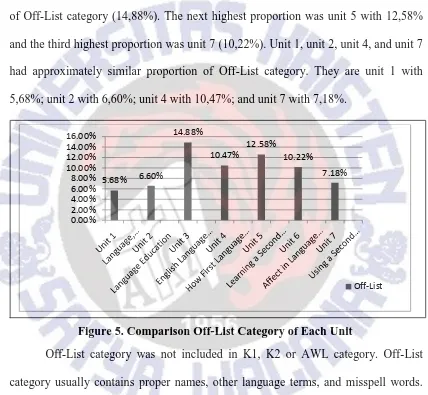1
Vocabulary Profile of Introduction to Language Education Textbook Argo Dhea Galuh Kirana Ardyny
Satya Wacana Christian University
Abstract
Vocabulary is a very important element in language learning as it conveys the meaning of certain words. Problems might occur if foreign language learners are not familiar with the words given. The objective of this study was to identify the vocabulary profile of the material in the Introduction to Language Education (2013) course. Based on the purpose, a descriptive method was used and all pages in the course book were used as the samples of the study. The analysis used an electronic tool, named The Compleat Lexical Tutor, v.4 developed by Cobb (1999). The study revealed three results; (1) 80,81% of the course book was understandable for university level while the rest of 19,19% was need much effort to comprehend; (2) unit 1 of the course book could be relatively easy to comprehend because it had the highest proportion of 1000 word list (K1) and the lowest proportion of Academic Word List (AWL), while unit 5 could be hard to comprehend because of its lowest proportion of K1 and its highest proportion of AWL; (3) unit 7 did not show the contrastive result of K1 and AWL however it still concluded as unit which was hard to comprehend.
Keyword: Vocabulary, Vocabulary Profile, Academic Word List, Compleat Lexical Tutor
Introduction
2
together. If foreign language learners only have grammar knowledge but do not have any sufficient vocabulary knowledge, they will get nothing. A hindrance might occur when foreign language learners do a reading activity and come across unfamiliar words. It is often possible to guess their meaning if the other words are recognizable. The problem is if there are lots of unknown words frequently appear in the text. Thus foreign language learners cannot expect to succeed on assignments because they do not understand the directions. According to Nation (2001) learning occurs if at least 95% of the running words are recognizable. Matsuoka and Hirsh (2010) also suggested that it is required to reach 95% of text coverage to be familiar with other words. Therefore, foreign language learners should be encouraged to improve their vocabulary knowledge through sufficient vocabulary learning.
There are many strategies of learning vocabulary used by foreign language learners to improve their vocabulary knowledge. Several vocabulary learning strategies aim to comprehend the meaning of certain word, sentence or paragraph. One strategy is by examining vocabulary profile. Knowing vocabulary profile of a particular text helps foreign language learners to decide the most suitable material based on their own familiar words list. Vocabulary profile is also significant to help learners choose the vocabulary learning. Morris and Cobb (2004) stated, “Vocabulary profiles proved to be useful in carrying out a finer assessment of the language skills
of high proficiency of nonnative speakers than oral interview can offer.” Examining
3
Cobb (ND) named The Compleat Lexical Tutor, v.4 and can be accessed at http://lectutor.ca.
Previous studies explored the potential for using vocabulary profiles as predictors of academic and pedagogic success and grammatical and lexical knowledge (Cobb, T. & Morris, L., 2004; Morris, L., 2001). The studies were
gathering TESL and TEFL trainee as the participants and using trainees’ text,
4
objective, the research question was, what is the vocabulary profile of the course book in Introduction to Language Education? This study could be beneficial for teachers because by knowing the vocabulary profile of course book, teachers can pay attention to the words contained in the textbook and decide what words may create difficulties for students. The teacher would also be able to select suitable reading material.
Literature Review
Vocabulary is known as a very important element within a language since the majority of its meaning is carried lexically. Vocabulary according to Nation (2001) is divided into four major types. They are high-frequency words, academic vocabulary, and technical vocabulary and low-frequency words. This type distinguishing is made in order to decide which of these types contains the words that foreign language learners need (Nation, 2001). The high frequency words are words which cover about 80% in a particular text. This type frequently occurs in all kinds of texts. Schmitt and Schmitt (2012) argued that, “High-frequency English vocabulary should include the most frequent 3,000 word families,” (pg. 1). On his previous study, Schmitt (2000) also stated that the 2000 words level is the basic initial goal of many second language learners thus it offer poor opportunity for deepening word knowledge (Matsuoka and Hirsh, 2010). Cobb (ND) also stated that, “The first 2000 words have been identified
and made somewhat easy to learn,” (pg. 5). On the other hand, the academic
5
the running words in an academic text (Coxhead, 2000). According to Cohen, Glasman, Rosenbaum-Cohen, Ferrara, and Fine, academic vocabulary causes a great deal of difficulty for learners, (as cited in Coxhead, 2000, p. 213). In her study, Coxhead (2000) also stated that by focusing on academic vocabulary, learners get the chance to make this significant vocabulary a part of working knowledge of the
language and thus make learners’ academic study more controllable. Corson argued
that, “Good knowledge of academic vocabulary is essentially for success at higher
levels of education” (as cited in Coxhead, 2000, p. 230). Besides, the technical
vocabulary only appears sometimes frequently in specialized texts and covers only 3% of the running words in a specialized texts. Different with the other type, the low-frequency words are words which rarely appear in a text or only cover 4% of the words in any texts (Nation, 2001). In his study, Cobb (ND) also stated that, “these words are difficult to learn because they are relatively infrequent and are not
encountered over and over again.” Dissimilar with Nation (1990), Schmitt and
Schmitt (2012) proposed the other type of vocabulary which is mid-frequency vocabulary. This type is labeled the vocabulary between high-frequency (3,000) and low-frequency (9,000+).
6
in her study stated that, “Small increments of vocabulary knowledge contribute to
reading comprehension” (pg. 15). Matsuoka and Hirsh (2010) in their study also claimed that strong link between vocabulary knowledge and reading comprehension is presence. Thus non-native English language learners should develop their vocabulary knowledge through sufficient vocabulary learning.
One of vocabulary learning strategies whose aim to comprehend the meaning of word, sentence, or paragraph is examining vocabulary profile of certain text. Vocabulary profile or Lexical Frequency Profile (LFP) contains the frequency of the word list that occurs in a certain text. According to Nation (2001), word list is as source of useful information about particular words and as a collection of the most important vocabulary for learners of English. The word list is given in a percentage so the user of the list can easily decide which meaning and use is the most important. Nation (1990) distinguishes word list into four different types. They are the first thousand most common (K1), the second thousand (K2), the Academic Word List (Coxhead, 2000), and off-list words (OL). Morris and Cobb (2004) stated that,
“Vocabulary profile provides breakdowns that include percentages from the type of
word list”. According to Meara (2005), LFP was first introduced by Nation as a tool
7
low-frequency versus high-frequency words in a learner’s production by means of the computer program Vocabprofile (www.lextutor.ca/vp) (Bardel & Lindqvist, 2011).
The Study
This study examined vocabulary profile of Introduction to Language Education (2013) course book used by English Teacher Education Program students. This study used all pages in the course book as the sample of the research to indentify the vocabulary profile of the textbook. The selection was based on the following reason: (1) this course is one of requirement courses for English Teacher Education Program students, (2) this book is in university level, and (3) this book is a base of English education course. A descriptive method was used to identify the vocabulary profile of material whether they belongs to 1000 word list (K1), 1001-2000 word list (K2), the Academic Word List (Coxhead, 2000), or other.
8
vocabulary profile of the certain text would appear. After that save the result provided by the program. This program can also be saved in Microsoft Word by clicking Edit/print-friendly table for further reading and analysis of the vocabulary profile.
The data were automatically calculated by The Compleat Lexical Tutor, v.4 tool. The data were grouped into the first thousand most common (K1), the second thousand (K2), the Academic Word List (AWL), off-list words (OL), and function words (F). The analysis also showed the breakdown of the word family list.
Findings and Discussion
The discussion of this chapter presents the answer of the research question,
“What is the vocabulary profile of Introduction to Language Education course book?”
9 Vocabulary Profile in general
The following section shows the identification of vocabulary profile of Introduction to Language Education course book in general. The comparison across category indicates that the majority 76,51% of vocabulary fall under most frequent 1000 words of English (K1) and were represented by the word like language, number, learning, and teaching. Then 4,30% of vocabulary fall under the second most frequent thousand words of English (1001 to 2000 / K2). The words included on K2 were rival, telephone, composite, and essentially. The 10,47% vocabulary fall under the academic words of English (Academic Word List or AWL). Words such as attribute, source, communication, and acquisition were the examples. The rest 8,72% under the word list which were not found on the other lists and were represented by the word like sociolinguistics, gestures, vocal, conventionalized.
10
Below is the comparison of each category across unit. The category gives the breakdown of each category across unit into K1, K2, AWL, and Off-List category.
K1 Category (1-1000 words)
Figure 2 provides comparison of K1 category across units in the course book. From the finding, unit 1 had the highest proportion of K1 words (81,02%). The next highest proportion was unit 7 with 78,91% and the third highest proportion was unit 2 (78,74%). Unit 3, unit 4, unit 5, and unit 6 had approximately similar proportion of K1. They were unit 3 with 74,34%; unit 4 with 74,27%; unit 5 with 73,92%; and unit 6 with 75,07%.
Figure 1. Vocabulary Profile of Introduction to Language Education Course Book 76.51%
4.30% 10.47% 8.72%
0.00% 20.00% 40.00% 60.00% 80.00% 100.00%
K1 K2 AWL Off-List
11
The proportion of K1 seems to depend on the topic discussed in each unit. If the topic discussed general thing, the proportion of K1 and the comprehensibility of the topic could be high because the proportions of K1 words was high. Unit 1 had the highest proportion of K1 because the topic was about introduction to language, acquisition, learning, and teaching. Thus it used words which belonged to K1 to explain the concepts in introduction. Due to the high proportion, unit 1 could be easy to comprehend compared to the other units. Different with unit 1, the proportion of K1 in unit 7 was less 2,11 point than unit 1 but still remained the second highest proportion among all units. In unit 7, the topic discussed was about the affect of language education, thus the proportion of K1 was not as high as the proportion on unit 1. The third highest proportion of K1 was unit 2 with a topic still about
Figure 2. Comparison K1 across units 81.02%
78.74%
74.34% 74.27% 73.92% 75.07%
78.91%
70.00% 72.00% 74.00% 76.00% 78.00% 80.00% 82.00%
12
introduction but it more focused on language education, It did not use as many words that belonged to K1 category in unit 1. While unit 3, unit 4, unit 5, and unit 6 had approximately similar proportion of K1 because the units had more serious on details about language education, thus, the proportion of K1 words used in each unit were lower than that in unit 1, 2 or 7.
K2 Category (1001-2000 words)
Figure 3 provides the comparison of K2 used in every unit from the course book. From the findings, unit 4 had the highest proportion of K2 category (5,86%). The next highest proportion was unit 6 with 5,16% and the third highest proportion was unit 7 (4,19%). Unit 1, unit 2, unit 3, and unit 5 had approximately similar proportion of K2. They were unit 1 with 4,01%; unit 2 with 3,94%; unit 3 with 3,80%; and unit 5 with 3,61%.
Figure 3. Comparison K2 for each unit
4.01% 3.94% 3.80%
5.86%
3.61%
5.16%
4.19%
0.00% 1.00% 2.00% 3.00% 4.00% 5.00% 6.00% 7.00%
13
From K2 perspective, it could be assumed that the higher the proportion of K2 in certain unit, the harder the unit is to comprehend. Thus from the finding, the highest proportion of K2 was unit 4 with the topic about the explanation on how first language is acquired. In explaining this topic, unit 4 used more K2 words. Similar with unit 4, unit 6 which had the second highest proportion of K2, indicating that this unit was also hard to comprehend. Since the topic discussed in unit 6 was about affect in language learning, unit 6 needed more complex words that included in K2 word category. The third highest proportion of K2 was unit 7. In this unit the K2 words were used more to explain about using a second language. Thus this unit also remained as unit which could be hard to comprehend.
Academic Word List
14
AWL words category represents the most difficult words to comprehend. Thus, it could be concluded that high proportion of AWL may cause comprehension of the unit difficult. From the finding, unit 5 had the highest proportion of AWL. Therefore, unit 5 considered as unit which was hard to comprehend. This happened because its topic was about learning a second language which needed more academic words such as acquisitions, maturation, constraints, and adulthood. The second highest proportion of AWL was unit 6 which discussed affect in language learning. Because the topic had several terms in explaining the affect, the proportion of AWL in this unit was high. The third highest proportion of AWL was unit 7. This unit discussed about using a second language, thus academic words used to explain the topic.
Figure 4. Comparison AWL for each unit
9.31% 10.73%
8.48% 9.67%
11.92% 11.36%
10.84%
0.00% 2.00% 4.00% 6.00% 8.00% 10.00% 12.00% 14.00%
15 Off-List Category
Figure 5 provides the comparison between Off-List words category used in every unit from the course book. From the finding, unit 3 had the highest proportion of Off-List category (14,88%). The next highest proportion was unit 5 with 12,58% and the third highest proportion was unit 7 (10,22%). Unit 1, unit 2, unit 4, and unit 7 had approximately similar proportion of Off-List category. They are unit 1 with 5,68%; unit 2 with 6,60%; unit 4 with 10,47%; and unit 7 with 7,18%.
Off-List category was not included in K1, K2 or AWL category. Off-List category usually contains proper names, other language terms, and misspell words. Unit 3 that had the highest number of Off-List category explained the history of language education in Indonesia, thus, it contained several Indonesian terms in language education and name of scholars. Unit 5 remained as the second highest proportion of Off-list category because it contained several scholar names such as
16
Krashen, Gass, Swain, Van Lier, and Varonis discussed the theory about learning a second language. In explaining about using a second language, unit 7 also used several Indonesian terms in comparing about English education in English speaking countries and that in Indonesia.
Conclusion
17
discussed. Nevertheless, unit 7 could be assumed as hard to comprehend because it had the third highest proportion of AWL.
However, this study still has limitation. The limitation is that this study only used one text book which was at university level to be analyzed. Having more than one book to be analyzed will be more beneficial for the reliability of the study.
18 Acknowledgement
This study was done with a lot of support. Therefore, I would like to thank the Lord for His blessing and guidance in finishing this study. I would like to express my sincere gratitude to my supervisor, Prof. Gusti Astika, M. A. for his immeasurable supervision and help during the completion of my thesis, and also my examiner, Rindang Widiningrum, M. Hum for the fundamental suggestion and guidance for this thesis.
19 References
Bardel, C., & Lindqvist, C. (2011). Developing a Lexical Profiler for Spoken French L2 and Italian L2. Eurosla , 75-93.
Chapelle, C. A., & Jamieson, J. (2008). Tips for Teaching with Call: Practical approaches to computer-assisted language learning. New York: Pearson Education.
Cobb, T. (ND). The original idea behind this website: Why & how to use frequency lists to learn words. Retrieved April 24, 2014, from Compleat Lexical Tutor: http://www.lextutor.ca/research/.
Cobb, T., & Morris, L. (2004) Analysis of TESL and TEFL Trainees' grammatical and lexical knowledge.
Coxhead, A. (2000). A New Academic Word List. TESOL Quarterly , 34 (2), pp. 213-238.
Introduction to Language Education. (2013). A Course book, Satya Wacana Christian University. Salatiga
Laufer, B. (2010). Lexical Threshold Revisited: Lexical Text Coverage, Learners' VOcabulary Size, and Reading Comprehension. Reading in a Foreign Language , 22 (1), 15-30.
20
Matsuoka, W., & Hirsh, D. (2010). Vocabulary Learning through Reading: Does an ELT Course Book Provide Good Opportunity? Reading in a Foreign Language , 22 (1), 56-70.
Meara, P. (2005). Lexical Frequency Profiles: A Monte Carlo Analysis. Applied Linguistics , 26 (1), 32-47.
Morris, L. (2001, November). The Use of Vocabulary Profiles in Predicting the Academic and Pedagogic Performance of TESL Trainees. International Language in Education Conference .
Morris, L., & Cobb, T. (2004). Vocabulary Profile as Predictorsof the Academic Performance of Teaching English as a Second Language Trainees. System 32 , 75-87.
Nation, I. S. (2001). Learning Vocabulary in Another Language. Cambridge: Cambridge University Press.
Nation, I. S. (1990). Teaching and Learning Vocabulary. Boston, Massachusetts: Heinle and heinle.
Nation, P., & Waring, R. (1997). Vocabulary Size, Text Coverage, and Word List. In N. Schmitt, & M. McCarthy, Vocabulary: Description, Acquisition and Pedagogy (pp. 6-19). Cambridge: Cambridge University Press.
21
Schmitt, N., & Schmitt, D. (2012). A Reassessment of Frequency and Vocabulary Size in L2 Vocabulary Teaching. Cambridge Journal , 1-20.





